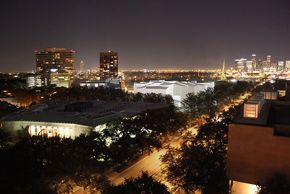#FutureMFAH January 19, 2015

Aerial night view of the Susan and Fayez S. Sarofim Campus, with the Nancy and Rich Kinder Building and the Glassell School of Art. Courtesy of Steven Holl Architects.
View of the campus from the Glassell School of Art's rooftop garden. Courtesy of Steven Holl Architects.
View of the Nancy and Rich Kinder Building restaurant entrance from the the Lillie and Hugh Roy Cullen Sculpture Garden. Courtesy of Steven Holl Architects.
The Sarah Campbell Blaffer Center for Conservation, looking from Fannin Street at Binz. Image: Lake|Flato Architects.
View of the Glassell School of Art facade from The Brown Foundation, Inc. Plaza. Courtesy of Steven Holl Architects.
Rooftop garden? Check. A new restaurant and theater? Check. Public plazas and reflecting pools? A walkable 14-acre campus? A translucent building to display 20th- and 21st-century art? Yes! All of the above, and more, for the future Fayez S. Sarofim campus of the MFAH.
The Museum is about to transform. Over the next five years, the campus is undergoing a dramatic redevelopment, adding three new structures: another major gallery building, a conservation center, and a new home for the Glassell School of Art.
Complemented by enhanced green spaces, these new buildings complete the Museum’s suite of notable architectural features from the past century. Here’s a time line of highlights:
20th Century
- 1924 | The original building, designed by Houston architect William Ward Watkin in the Greek Neoclassical style, is the first art museum built in Texas.
- 1953 | The Blaffer Memorial Wing, by Houston architect Kenneth Franzheim, opens.
- 1958 | Cullinan Hall, a free-span exhibition space designed by German-born American architect Ludwig Mies van der Rohe, is completed.
- 1974 | Brown Pavilion, also by Mies, adds a new entrance lobby, an expansive second-floor gallery, and a theater.
- 1986 | The Lillie and Hugh Roy Cullen Sculpture Garden, by American landscape architect and sculptor Isamu Noguchi, takes a modern approach to the traditional garden.
- 1998 | The Caroline Wiess Law Building becomes the name of the Museum building, in honor of the longtime patron.
- 2000 | The Audrey Jones Beck Building, by Spanish architect Rafael Moneo, adds more than 85,000 square feet of gallery space, along with a new shop, café, and offices.
21st Century
- 2017 | The Sarah Campbell Blaffer Foundation Center for Conservation, by Lake|Flato Architects of San Antonio, provides a two-story facility atop the Museum’s existing parking garage, adding conservation labs and studios, and a street-level café.
- 2017 | The new Glassell School of Art, by New York’s Steven Holl Architects, extends the landscape of the campus with The Brown Foundation, Inc. Plaza, walkable roof garden, reflecting pool, café, and art-supply store.
- 2019 | The Nancy and Rich Kinder Building, a translucent structure also by Steven Holl Architects, adds two floors of galleries that circle a three-level atrium, as well as a restaurant, café, theater, reflecting pools, vertical gardens, meeting rooms, connectivity to the Glassell School, and underground parking.
Join us on this grand adventure! We’ll announce more details as they unfold, so follow along with #FutureMFAH for the latest news. Connect with us on Facebook, Twitter, Instagram, and Vimeo.





